Turtle on Beach Baby Sea Turtle on Beach
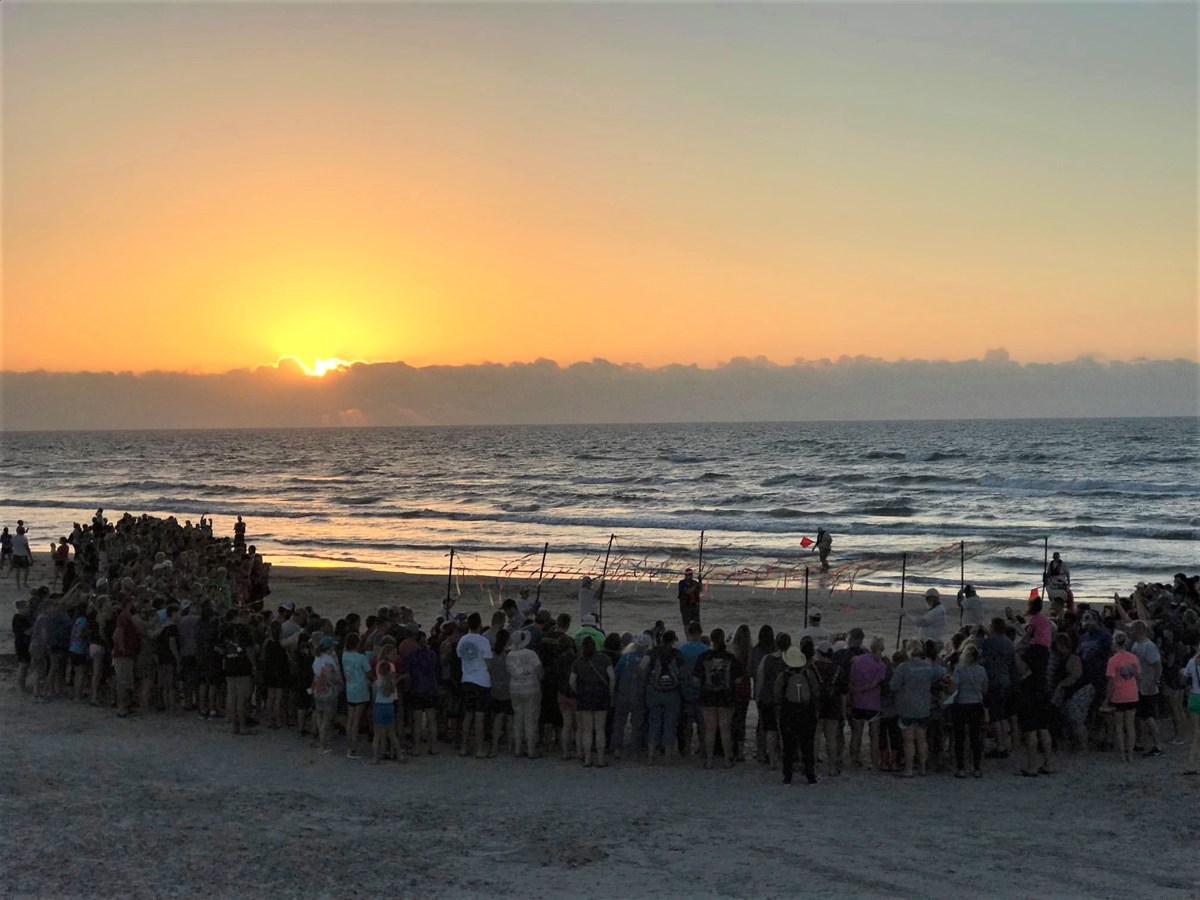
NPS Photo.
During the summer at Padre Island National Seashore we release Kemp'south ridley sea turtle hatchlings from nests that were laid in the park and along parts of the Texas declension.
Hatchling releases typically occur from mid-June through August. Most releases that are open up to the public take place at 6:45 a.m. on Malaquite Beach in front of the Visitor Eye at Padre Island National Seashore on N Padre Island in Corpus Christi, Texas.
NOTE: Most GPS units and smart phones do Non accurately locate the park and volition lead you to the wrong place! Please follow our map and directions to detect the park and the public hatchling release site.
Because nosotros cannot predict exactly when a sea turtle nest will hatch, non all hatchling releases are public, and hatchling releases do not occur daily or on a regular schedule. Like all babies, the hatchlings determine when they are ready. Similar to a man pregnancy, each nest plant is given an approximate "due date" - a range of dates during which we call up that the nest will nigh likely hatch. Cheque our Current Nesting Season folio to run across how many nests have been constitute this yr and when they are expected to hatch.
Your chances of seeing a bounding main turtle hatchling release are best when several nests are due to hatch at about the same fourth dimension. If you tin can, programme to visit over a flow of several days when multiple nests are due to hatch. One time those dates are almost,phone call our Hatchling Hotline (361-949-7163) or bank check our Body of water Turtle Program Facebook Page or Park Facebook Folio to observe out the latest information about the next scheduled public release.
Hundreds of people may exist at a public hatchling release. More people nourish the first release, on weekends, and on holidays. Even so, the hatchlings usually have 20-45 minutes to make their way across the beach and into the water, affording time for everyone to get a skilful view. Volunteers and Park Rangers too bring hatchlings around for visitors to get a close-up wait and have no-wink photos.
Tin't make information technology out to the National Seashore to watch a hatchling release? Don't worry, you can view videos of by hatchling releases on our YouTube Channel.
Ofttimes Asked Questions
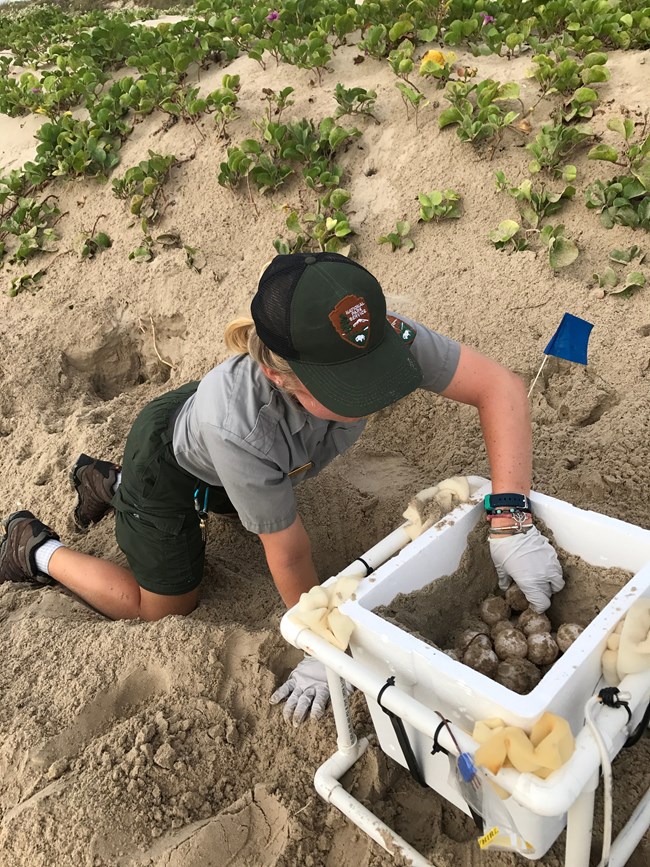
NPS Photo.
Do yous e'er release sea turtles at other times of the year?
Sometimes we release cold stunned sea turtles during the winter, simply those releases are very unlike. Check out our Cold Stunned Body of water Turtles page for more than information well-nigh releases of bounding main turtles during the winter. For information on how you might see bounding main turtles (either in the wild or during a public release) in this area at different times of the yr, go to our How to Run across a Sea Turtle page.
Where do the nests come from? How practice you find them?
Sea turtles must leave the water and clamber up onto the beach to lay their eggs. When a sea turtle nests, she digs a pigsty deep in the sand, lays her eggs in the hole, then covers the eggs with sand to hide them from predators. Afterwards nesting she returns to the sea, leaving tracks every bit she crawls beyond the beach. She never comes back to cheque on the eggs or hatchlings. The Kemp's ridley, the sea turtle found nesting about oft in Texas, nests anytime between April and August.
Each year, all along the Texas coast, different organizations and volunteers patrol the beaches, looking for the females on the beach, the tracks left by the females, or other signs that nesting occurred. Specially trained and permitted staff help locate the eggs that are buried deep in the sand.
Where are the nests? Can we encounter them?
All ocean turtle nests that are found when they are laid are moved to protected areas. Some nests are moved to fenced beach areas chosen corrals. Others are moved to an incubation facility. These protected areas where the nests are incubated are non open up to the public because the embryos developing in the eggs are extremely frail and may not survive if disturbed. But even if these areas were open, the eggs are buried in the sand and are non visible. All you tin see are containers of sand or a fenced area of sand.
Sometimes a nest is not found and incubates at the original nesting site. This is chosen in situ incubation. These nests are sometimes plant afterward, when a predator digs down and eats the eggs or when some of the eggs hatch and the hatchlings dig their way up to the surface.
Why do y'all move the nests?
Nosotros move the nests to increment the number of eggs that hatch and the number of hatchlings that survive. Nests left where they are laid on the beach (in situ) often take depression hatch and survival rates due to predation, tidal inundation, crushing by vehicles driving on the embankment, and other hazards. Sea turtle numbers are likewise low to beget any losses at this time, so all nests establish in the park are moved to protected areas and monitored until they hatch.
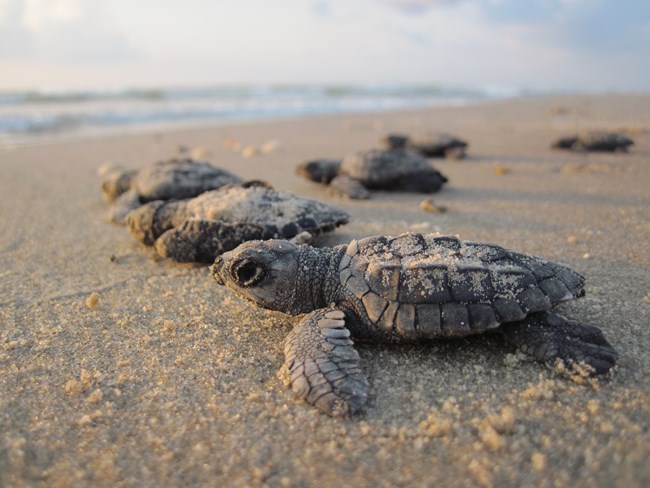
NPS Photograph.
How soon after hatching are the bounding main turtles released?
Hatching is a slow process. Information technology can have 1-4 days for the baby turtles to pause through the eggshell, sally from the egg, and be fix for release. Once they are fully emerged from the egg, hatchlings are released equally soon as they are fix, usually within 24 hours.
Tin we touch the baby turtles?
Unfortunately, we cannot allow anyone to touch the hatchlings. Even the staff and volunteers, who are authorized past federal and country permits to handle the hatchlings, wear gloves. Sea turtle hatchlings imprint to their natal beach during hatching and release. Imprinting is a complicated procedure that is essential for the female hatchlings to one day find their mode back to their natal beach every bit adults to nest and continue the species. The chemicals found in sunblock, moisturizer, or even the natural oils institute on homo pare may interfere with this important process.
Why do yous make the hatchlings crawl on the beach - why not just release them directly into the water?
We make the hatchlings clamber on the embankment for several reasons. Letting them crawl on the beach helps them "wake upward" - after all, they are merely a few hours former! It also allows united states of america to assess each hatchling to make sure it is completely ready to exist released - alert, able to move and crawl, oriented to the water, able to swim, and able to come up upwardly to breathe air equally it swims away.
Bounding main turtles lay their nests up on the embankment, sometimes all the way up into the dunes. When the nests hatch, the newly hatched turtles crawl on the beach from the nest to the surf. We allow turtles from relocated nests to clamber down the beach as they would in nature. Time spent crawling on the beach is likely an essential part of the imprinting process. Imprinting is a complicated process by which the elements of the beach where sea turtles hatch - sand, water, air, and other factors - are "programmed" into the brains of the baby turtles. Many years afterward, female sea turtles that may have traveled thousands of miles away render to the beaches where they hatched to lay their eggs and sustain the population. Imprinting allows this to happen.
Procedures for releasing hatchlings are set based on the needs of the turtles. Releases are open up to the public only when it is compatible with hatchling needs. Fortunately, when conditions practise let for visitors to watch hatchlings get released, the procedures followed commonly offer plenty fourth dimension for anybody who comes to meet and learn almost these rare and magnificent animals.
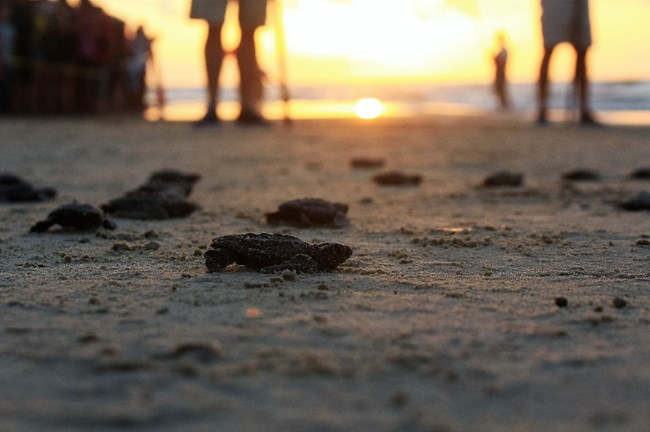
NPS Photo.
Why are releases so early in the morning?
Public hatchling releases have place around sunrise due to a combination of factors. The nigh of import factor involves the biological needs of the hatching turtles.
Although it tin take ane-4 days for a nest to hatch, most hatchlings reach a point where they tin can be released sometime during the night or in the early on morning. As they sally from their eggs, hatchling sea turtles are often lethargic and tedious, using lilliputian energy. But the newly hatched turtles accept a special, limited free energy reserve. Borer into this energy helps them climb their way to the surface, crawl across the embankment, swim against waves to open waters until they can notice a safe place to hide. They do not eat for their first few days of life, and must rely on their free energy reserve to survive their journeying.
Once newly hatched bounding main turtles outset moving around and becoming active, they brainstorm burning off their reserved energy. The active, high-energy state is called a frenzy. Information technology can happen at any fourth dimension; however, it typically occurs at night or early morning. If the hatchlings begin to frenzy, they must be released as soon as possible to ensure they volition accept the free energy they need to survive.
Since hatchlings are more likely to be fix for release during the nighttime or in the early on morning time, public releases are scheduled for the early on morning to fit within the biological needs of the hatching turtles. But if the hatching turtles begin to frenzy during the nighttime, they are immediately released and the public release may exist cancelled, unless there are other nests fix for release.
The plan aims to increase public sensation of sea turtles and promote support for their conservation. Allowing visitors to meet and learn most live sea turtle hatchlings, as long as it fits within the biological needs of the turtles, is one of the almost effective ways to reach the public. Just public releases only take identify when weather condition permit. Only a portion of turtles hatched in the park are released during public releases. Many enter their frenzy and are released at dark at diverse locations in the park to prevent predators from congregating at 1 release location.
Why can't you schedule the release before than the day before it happens? And why are releases cancelled at the last infinitesimal?
Hatching is an unpredictable process. It tin take 1-4 days from the time a nest begins to hatch until the hatchlings are ready to be released. In one case a nest begins to hatch, our sea turtle biologists monitor the nest closely. As hatching progresses, biologist endeavor to approximate when the hatchlings will be prepare. If, by mid-day, it looks like hatchlings from that nest volition exist ready for release within the next 12-xvi hours, a public release may be scheduled for the adjacent morning.
But much of what is occurring is below the surface of the sand, and in the finish, it is up to the babies to make up one's mind when they are ready to go! Sometimes they go very active and must be released during the middle of the night to ensure survival. Sometimes they take longer to hatch than initially thought and are non ready for release. In some cases, depending on how many nests are involved, the public hatchling release may end up being cancelled. We update our Hatchling Hotline (361-949-7163) and Facebook pages as soon as we tin can, but that may be at 3:xxx a.m. So it is best to call the hotline or check our Sea Turtle Program Facebook Page or Park Facebook Page earlier you bulldoze to the park to ensure a public hatchling release will occur. Delight note, forecasts of thunderstorms or other severe weather events immediately before or during a hatchling release, may contribute to the cancelling of a public release.
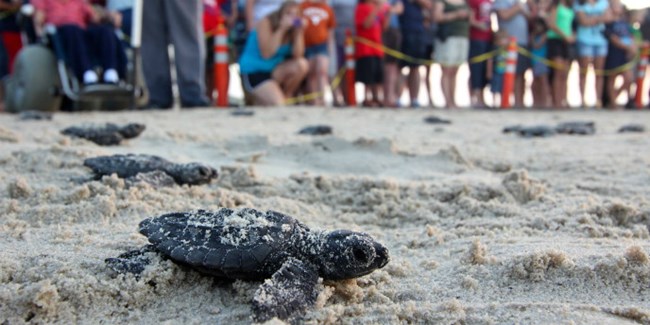
NPS Photo.
What is the best way to find out virtually the adjacent hatchling release?
Call our Hatchling Hotline (361-949-7163) or bank check our Ocean Turtle Program Facebook Page or Park Facebook Page to find out the latest information near the next scheduled public release.
Can I take pictures or video?
Yep, equally long as no flash or calorie-free is involved. Lights, including flash photography or video, disorient the hatchlings and tin can even reduce their chances of survival past causing them to wander and burn off their express free energy reserve. When you arrive at the release site, please make a point to ensure whatsoever flash or lights are turned off on all cell phones, cameras, and video equipment.
I have mobility concerns. Is in that location a style for me to meet a release?
Aye. The park offers free loan of beach wheelchairs to those with mobility concerns. These wheelchairs are specifically designed for use on the beach. They cannot exist cocky-propelled and require another person's help. An accessible ramp goes from the company eye pavilion down to the embankment where the public releases are held. Beach wheelchair supplies are very limited and are available on a first-come, first-served basis (no reservations). Call the Malaquite Visitor Center at 361-949-8068 for more information.
Can I bring my canis familiaris with me to the hatchling release?
Yeah, but it must exist on a leash no longer than 6 feet that you hold onto at all times. Also, dogs are not allowed to be anywhere near any of the hatchlings since dogs have been documented killing and eating sea turtle hatchlings. Be aware that there will be a large crowd. If your dog is not comfortable around crowds of people or if you are non sure, please to not bring them. Call the Malaquite Visitor Middle at 361-949-8068 for more data about pets in the park. Service animals are allowed everywhere the public is allowed.
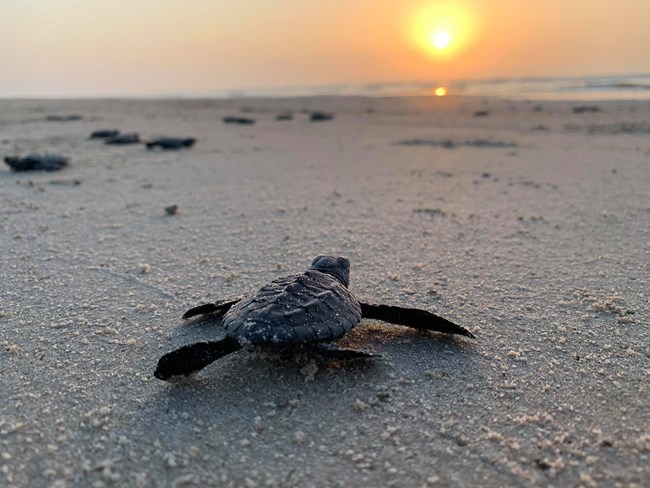
NPS Photo.
Is at that place anything else I need to know nearly attending a release?
Yes. Nosotros accept some very important guidelines for visitors attending public releases to help ensure the safety of the hatchlings and provide for a prophylactic and enjoyable experience for visitors.
- Keep 'em in the dark! Lights tin can disorient sea turtle hatchlings. They tin get lost, burn down off their free energy, or fifty-fifty get picked off easier past predators. Flashlights and flash photography are not immune. Please make sure the flash is turned off on your cell phone, camera, or video equipment.
- No white in sight. Hatchlings rely on the moon or sunlight shining on the h2o and the white foam of the waves to assistance them detect their mode. White vesture or shoes can confuse them. Those wearing white may be asked to move behind others and wind up with a less ideal view, so delight avoid wearing white.
- Foot-gratuitous zone! Hatchlings are very minor and easy to miss. We rope off a "track" of embankment as a prophylactic zone for the hatchlings to use equally they crawl across the beach and enter the h2o. The public gathers around the perimeter of this runway to picket the hatchlings. Staff and volunteers avert stepping into this expanse every bit much as possible to reduce the risk of stepping on and crushing a hatchling.
- Easily downward! Newly hatched sea turtles, virtually the size of a small-scale cookie, are bite-sized and tasty treats for many different predators. Gulls present a real threat to these tiny turtles. Unfortunately, gulls in the area are often fed by people and have learned to associate groups of people with food. Gulls are attracted to the crowds attending public hatchling releases for this very reason. Y'all tin can aid bounding main turtles by non feeding gulls or other animals. Do not bring food to a public hatchling release and avoid waving your arms at gulls that fly by - you will actually draw more than gulls because they assume you are throwing food.
- Air attack! Because of the increased threat from gulls at public hatchling releases, extra measures must be taken to protect the hatchlings. You lot volition see trained volunteers and staff who human activity as "guards" for the hatchlings. They hold up netting, flagging, or other materials to deter gulls, and may even take to pace out among the hatchlings - very, carefully - to keep gulls from swooping down and taking them.
- Institute your anxiety! As the hatchlings get close to the surf's edge, waves can sweep in and chop-chop carry them into the crowds of visitors watching the release. The hatchlings can get lost, tangled in something, or even stepped on and crushed. When a wave washes in, the homo impulse is to lift up your feet. But in doing then, you could accidentally stride on a hatchling! If a wave comes in around you, PLEASE proceed your anxiety planted in the sand and stand very still. Our trained staff and volunteers will come and find whatsoever hatchlings that got swept into the crowd and bring them dorsum into the safe zone.
- Give everyone a chance. Anywhere from a hundred to a 1000 or more people attend each public release. The perimeter of the release expanse is gear up not just to proceed the hatchlings safe but to give equally many visitors every bit possible a view of the hatchlings. The hatchlings usually have anywhere from xx-45 minutes to crawl down the embankment and into the water, and the crowd oft thins out as time passes, so at that place should exist enough time for everyone to get a good view. But it may still be difficult for some to see, peculiarly small children or visitors using wheelchairs. Please exist courteous and permit others to motion up to the front for a better view once you accept watched the hatchlings for a few minutes. Help us ensure everyone has a chance to see these rare animals upwardly close during what may be a once-in-a-lifetime experience.
- Don't "moving ridge" farewell to your shoes! Releases take place at the water'due south border, and then at that place's a good chance your anxiety will get wet. Incoming waves tin can sweep the shoes right off your anxiety! Wear shoes that will stay securely on your feet and concord onto your belongings. The surf has claimed many a flip-flop, car key, jail cell phone, and other important items!
- It's hot out there! Fifty-fifty though public releases take place around sunrise, the loftier humidity, crowded conditions, and summer heat can withal be intense. Please bring water with you lot (but do not bring food because of the gulls) - and drink it. A hat, sunglasses, and sunblock are also recommended. You lot tin even bring a embankment chair if you want to every bit long equally you sit down outside our release perimeter. Your safety is very important to us!
Source: https://www.nps.gov/pais/learn/nature/hatchlingreleases.htm
0 Response to "Turtle on Beach Baby Sea Turtle on Beach"
Post a Comment